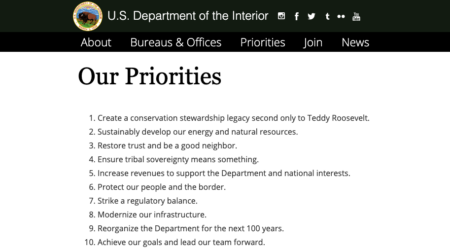Blog Insights
How to Prepare For a Government Website Redesign
Redesigning a government agency or department website is no small task. There is content to manage, stakeholders to involve, and processes to follow to ensure that the redesign meets your needs and subsequently launched successfully. Here are the essential areas to focus on when taking on a government website redesign.
Forum One works with local, state and federal government agencies. We help ensure that their digital communications platforms and strategies provide the right information and services in the best format for your audiences. This includes ensuring consistent branding and messaging, exceeding accessibility standards, ensuring the site is responsive and as easy to use on a cell phone as a desktop, and — above all — your government content is valuable and easy to use for those who need it most.
When starting a government modernization project or website redesign, broadly, you want to think about three major questions:
- What are your needs? This gets at the requirements. What are you looking to improve in the next iteration of your digital platform or service tool? How can it better serve your staff, reduce workloads, and show your impact, etc.?
- What do your users need? The primary goal of your website should be to meet the needs of your key stakeholder groups. Think about why they would come to it and what they need from it. This should serve as a foundation for your new website content and structure.
- What does your RFP need to convey? Developing the right starting point is essential to finding the right partners who can help you create the best possible website.
Government websites are often run out of either the Office of Communications (or Public Affairs) or the Office of the Chief Information Officer. Often the two teams collaborate in managing the site, with the communications team leading and the technology shop helping to get the technology, IT process and infrastructure in place (especially if you will be hosting the website internally).
It takes a village to launch a website, especially in government when there are different groups taking different actions (e.g., a security team, a 508 compliance testing team, content creation, content approvals, legal compliance or review for content, government approvals for designs, branding and/or imagery, etc.). If your web redesign will take a village, then try to talk to those teams first so you can understand who you need to get involved. If another group in your government agency has done a recent website redesign, then be sure to talk to them; they’ll have many valuable tips to share.
Let’s dive into the three biggest areas we see as essential for creating a solid base upon which your redesign will come to life.
Understanding the requirements
As with any new initiative, start with your goals. How can your digital platform support your agency’s mission? For example, the U.S. Department of the Interior’s goals clearly shares its broad agenda.

Your agency or bureau also has a mission, so be sure your digital initiative supports and clearly connects to your agency’s overall goals.
Create Requirements
Drafting a scope of work or a list of requirements can be specific or general. If you know your needs, then write them down so vendors can cost them out. We recommend being clear with what you want to accomplish, but not providing too much direction in terms of the exact layout of the page. After all, you’re hiring designers and user experience professionals who should be able to design the page to meet your goals effectively.
If you know you need a redesign, but don’t want to detail the specifics, then keep it broad. You can bring on a partner who will walk you through the process. This is often how we begin working with our government partners and is an excellent way to ensure you are setting out on the right path.
A general, open-ended Request for Information (RFI), in which you ask for approaches to solving specific problems can also help but adds a step to the process. We tend to see RFIs when exploring new technology areas such as Artificial Intelligence (AI) for government or Robotic Process Automation (RPA). This is more like fishing for ideas of solutions when you aren’t quite ready to define the parameters of the solution.
If you’re not able to clearly define your requirements then you may want to hire a contractor to help with just the discovery and requirements phase. They can help you understand your needs and your user’s needs before you dive into the project. This might be a good option if you are considering a brand new website with few parameters, or a new technology such as AI, Machine Learning (ML), or a data project that doesn’t have a long-established precedent.
Conducting market research
Government agency managers have several options when approaching a redesign; however, one especially important step is to conduct market research. This is true in the Federal government but varies by jurisdiction.
Why do you need to do this? For one thing, Federal rules require you show you’ve done the research in order to make sure the project you are planning is efficient, non-duplicative, and a good use of taxpayer money.
Here are a number of market research approaches you can take:
- Draft a Statement of Work (SOW) and get feedback from the industry by posting to a government schedule (e.g., IT Schedule 70).
- Contact vendors directly and ask for a budget estimate or reactions to a draft solicitation. You do not need a draft SOW to do this.
- Post an RFI to formally request feedback from interested vendors. This is like a mini RFP without all the fuss: determine what input you want, page length, etc. The format is flexible. Some RFIs ask for responses to specific questions, request corporate capabilities, or ask for short white papers in order to collect more consistent feedback. If you choose to go this way, be both brief and concise. This is unpaid work and as contractors and vendors prioritize responding to proposal or contract requirements, they are more likely to respond to RFIs that are a reasonable investment of time in order to improve the quality and accuracy of government RFPs.
For inspiration and ideas:
- Electronic Code of Federal Regulations (e-CFR) guidelines on market research (see part 10)
- U.S. Department of Veteran Affairs (VA) market research guide for acquisition teams
Developing the RFP
A big part of developing your Request for Proposal (RFP) is knowing which contract vehicle you should use. This can be a daunting question in itself, given all the choices available. Here are some questions to guide you through it:
- Consider the extent of the competition you want. If you think you have a pretty good idea of the vendors you’d want to target, and the contract vehicles they use, that can help steer you in the right direction. A common contract for federal digital technology services, such as a website build or data program, is GSA’s IT Schedule 70. If you want the broadest possible selection of vendors, you can use an open competition and post the RFP on wide sources like FedBizOpps, which is transitioning to SAM.gov. You get a large number of responses on this site which provides lots of options and adds to the timeline and complexity of your decision making.
- Get more insight from your agency’s resource bank. For example, GSA’s Federal Marketplace Strategy aims to revise the way GSA helps government agencies acquire services from vendors. It is a work in progress, but there is already a lot of valuable information to use.
- Streamline your efforts by targeting the small business community. It speeds up the procurement process and helps your agency meet small business utilization targets. Check with your Office of Small and Disadvantaged Business Utilization (OSDBU) office on your agency’s small-business utilization progress. The small business community is diverse and with deep expertise to handle most digital requirements, so don’t be afraid to explore it. Companies such as Forum One have deep experience in government contracting including website development, data visualization, and digital modernization.
As you consider ways to get your RFP out there, consider hosting an in-person or online Industry Day to share information about the new requirement and encourage collaboration among the vendor community. This is particularly useful for large projects that cover multiple offices within an agency, as it enables vendors to learn about the new requirement, encourages competition, and, and meets the requirement to share news about the acquisition with the public.
